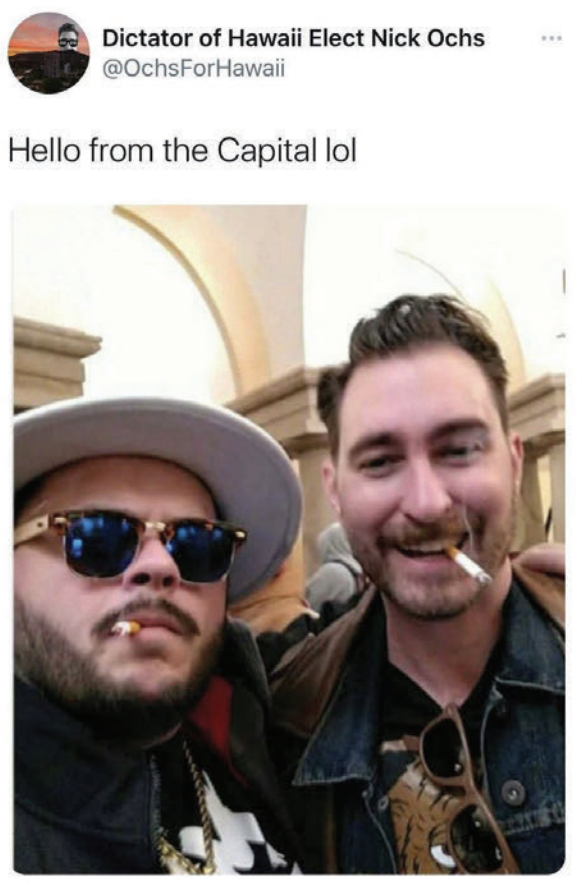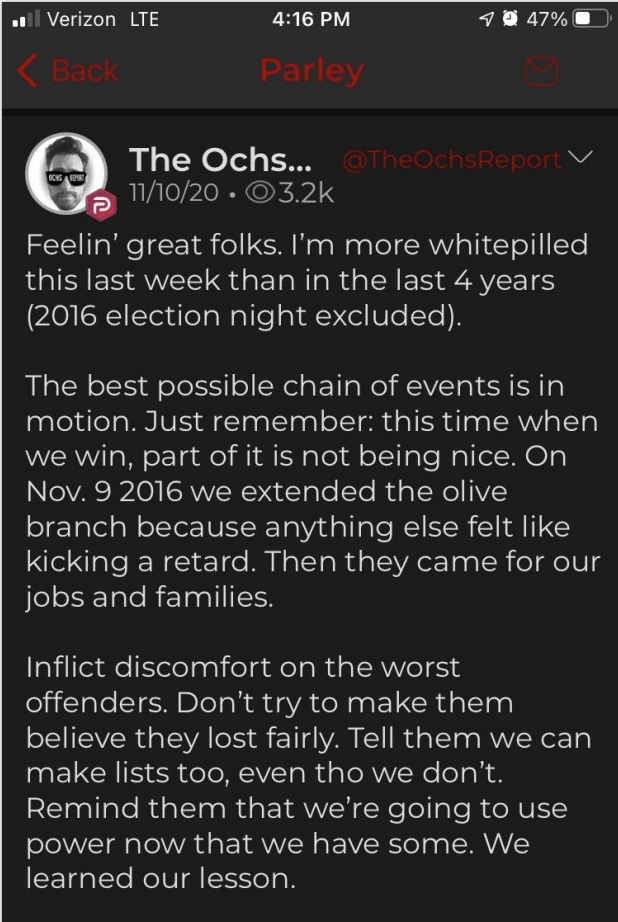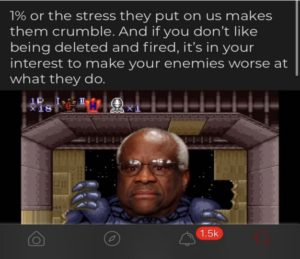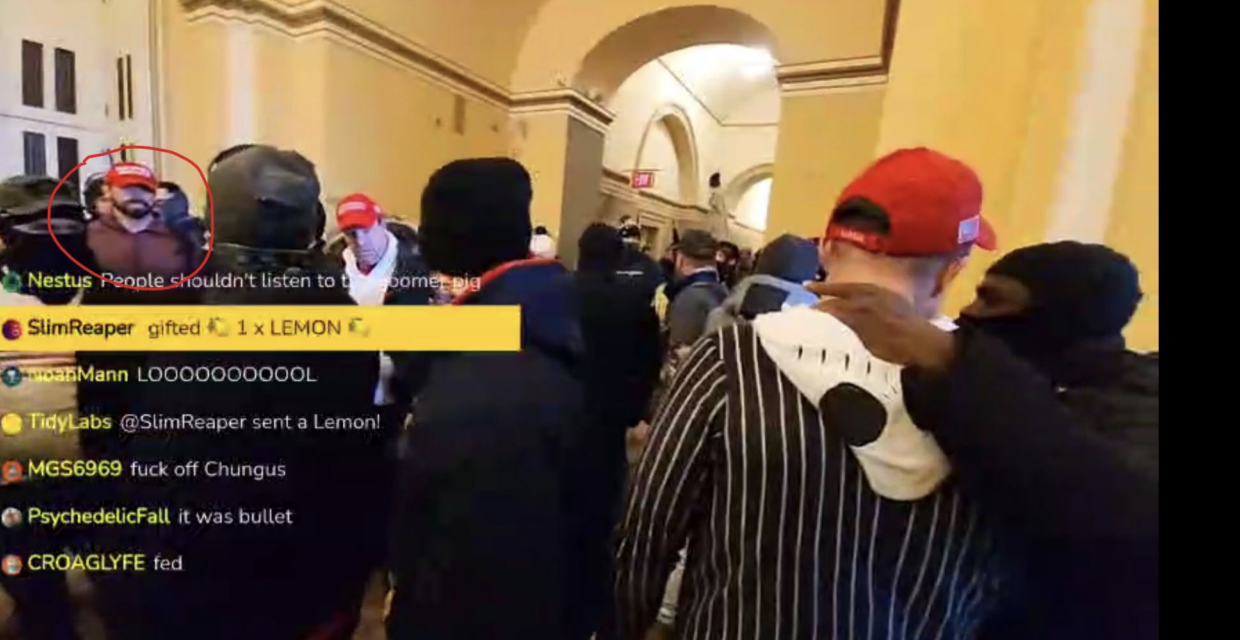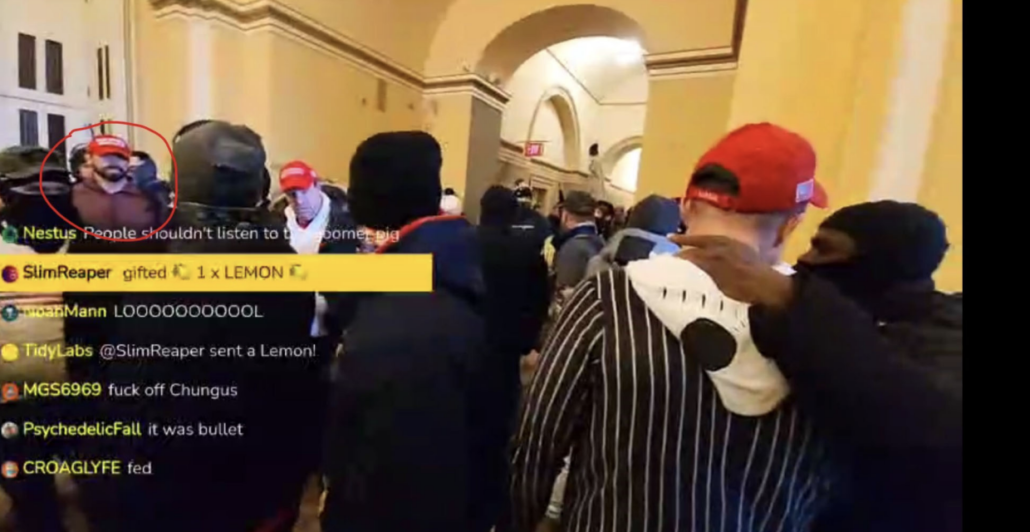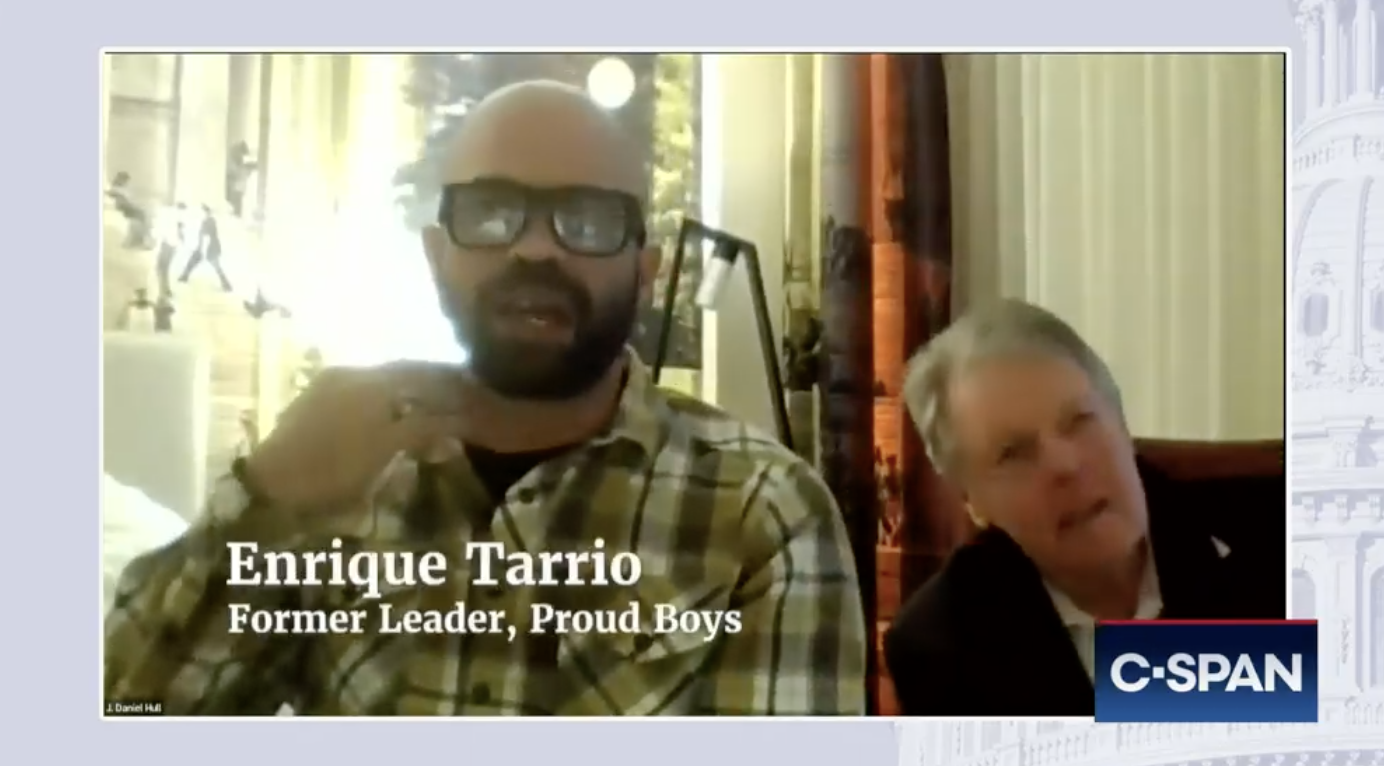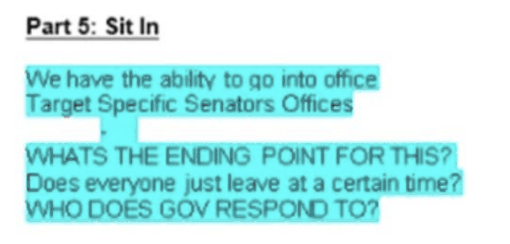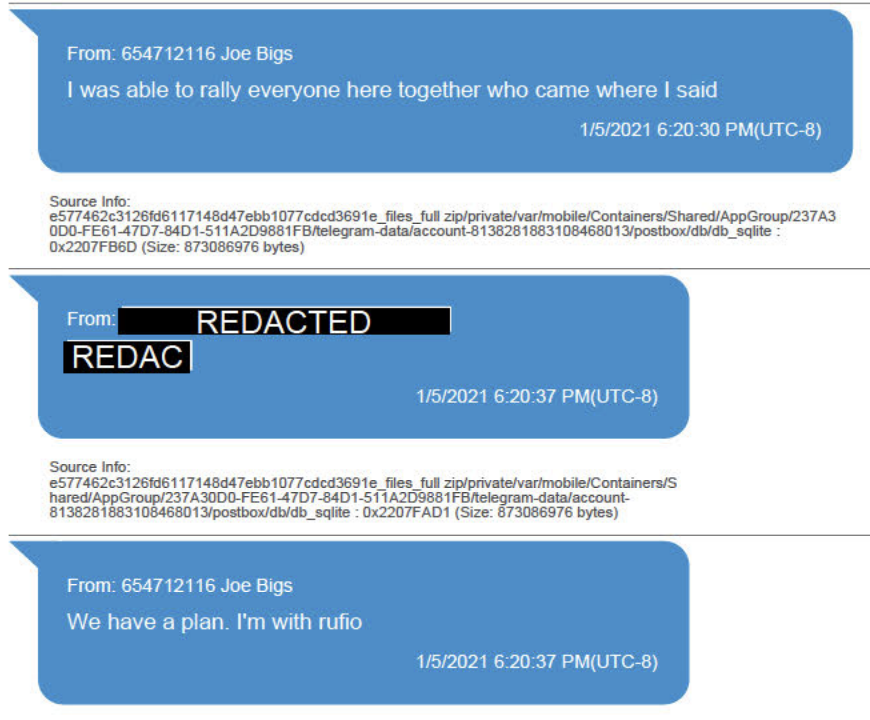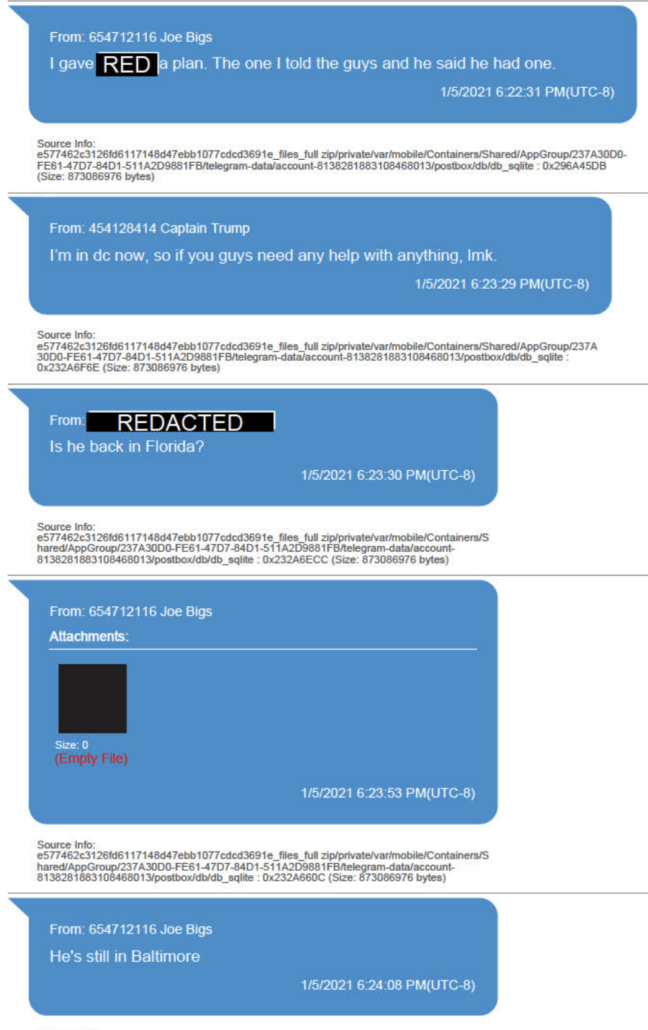Skull and Bones: The Proud Boys’ Non-Conspiratorial Secret Society?
The morning of January 5, according to the government sentencing memo for him, Proud Boy Nicholas Ochs texted Ethan Nordean to say that, in light of the arrest of Enrique Tarrio the day before, he and Nordean were, “senior leadership in DC till Enrique is sprung.”
Following Tarrio’s arrest, Ochs messaged Nordean the morning of January 5. He said, “I guess we’re senior leadership in DC till Enrique is sprung. I’ll be in today or tonight. Lemmie know anything relevant.” Nordean replied, “Ok will do,” and they traded cell phone numbers.
Och’s own sentencing memo addresses that comment, but doesn’t explain it.
[T]he government relies extensively on a single message by Mr. Ochs, where he offhandedly referred to himself as a leader, Dkt. 94, pg. 9, and a tasteless message in which Mr. Ochs states he is “pro-violence,” id., at 4, the government is unable to point to a single actual instance wherein Mr. Ochs actually performed the duties of a leader or acted out in violence during the January 6th riots.
He doesn’t explain what became of the message, if anything (there’s no mention of any calls between Ochs and Nordean, and Nordean’s phone was not operational during the riot).
At least on the surface, it looks like Nordean blew Ochs off.
Instead, and before that comment, Ochs makes a very strained comment — limited to before attending the rally and discussion about their planned activities for the day –about what he said to other Proud Boys on the day of January 6, while he and Nicholas DeCarlo were attending the Trump speech and most of the other the other Proud Boys were marching around DC.
On the morning on January 6, Mr. Ochs and DeCarlo went to the rally where the President was addressing the crowd. Mr. Ochs was dressed in normal civilian clothing and did not wear any special military or other riot gear—unlike the many others who attended the rally, dressed in military/assault garb, signaling their violent intentions. Mr. Ochs was armed only with a smartphone.
Before attending the rally, Mr. Ochs did not communicate with any other Proud Boy members regarding their planned activities for the day. Indeed, at no point during the rally or the resulting assault on the Capitol, did Mr. Ochs coordinate with other Proud Boy members. As is stated in the Statement of Facts, though Mr. Ochs did come across other Proud Boy members in Washington, these were chance encounters and not the result of any prior planning. During the rally itself, Mr. Ochs was unable to live stream the event because the local cellular system was overwhelmed, and given his physical location, he was unable to hear the president’s speech.
At the conclusion of the rally, after the President finished speaking on the Ellipse, Mr. Ochs began seeking out the larger crowd which had begun moving towards the Capitol building—the first of many bad decisions that day. [my emphasis]
Given the evidence, that’s a credible claim.
What’s not covered by Och’s narrow (albeit for sentencing, critical) denials was Ochs’ participation in some small member chat groups, including one, called Skull and Bones, that included Nordean and Enrique Tarrio.
Leading up to January 6, 2021, Ochs participated in several Proud Boys chats on an encrypted messaging application, including one called “Official Presidents’ Chat” and one called “Skull and Bones.” Skull and Bones consisted of a small group (approximately twelve) of the Proud Boys’ Elders, including Enrique Tarrio and Ethan Nordean, both of whom have been charged with seditious conspiracy and other crimes for their roles leading the Proud Boys on January 6. See United States v. Nordean et al., 21-cr-175 (TJK). Some of these chats ended and then were reconstituted (because of concerns about being “compromised”) in the days leading up to January 6.
Of some interest: while the Proud Boy Leaders prosecution used Och’s November 2020 advocacy to wait before embracing violence as a way to show the Proud Boys ratcheted up their willingness to embrace violence.
[A]s the defendants, their co-conspirators, and their tools got further from the election and closer to Inauguration, the language they used to discuss the transfer of power became more desperate and more reflective of a willingness to take matters into their own hands. See Ex. 1 (proposed trial exhibit referenced at 11/18 hearing, with Proud Boys “elder” counseling: “I’m pro violence but don’t blow your load too soon.”).
Here, the focus is on Ochs’ attempts to persuade others to await the Supreme Court, which he was sure would deliver victory to Trump.
In Skull and Bones, on November 7, 2020, the group reacted to Biden being declared the winner of the election. Tarrio said, “Dark times if it isn’t reversed…and if it’s reversed…civil war.” Another user commented, “It’s civil war either way.”
Ochs disagreed: “It’s really not. The odds are with us because of the Supreme Court boys. I’m pro violence but don’t blow your load too soon.” He continued, “Not to be an anti-murder buzzkill but I really think this ISN’T fucked. Once it is, let’s go wild.” Ochs advised the group, “Bush/gore ruling took till December…Trump has a MUCH stronger case.” Ochs said, “Americans are weak and don’t want to fight. Them more so than us, but what’s really going to matter to the common man is what the Supreme Court says. And it will say.”
Another member noted, “Interesting that Trump got that woman through just before this huh. Could be the ace up his sleeve.” Ochs agreed and reiterated his belief that the Supreme Court was the best option to overturn the election: “Don’t fuck up the ruling. It’s a better chance than fighting.” He advised the group not to turn violent yet: “Not till the law enforcement institutions [are] weakened or more on our side. We lose right now.” But he told the group: “I’ll still chimp out if I’m wrong about the Supreme Court tho…we just have to TIME IT RIGHT and DO IT SMART.” Another member proposed that “veterans with combat experience” should “form militias.”
Ochs also expressed optimism in Parler posts that the Supreme Court would overturn the election results, including an image of Justice Thomas as a video game character:
Tarrio and others discussed a conference call on December 19 after Trump announced the rally.
Ochs’ prediction that the Supreme Court would overturn the election results did not come true. Instead, courts rejected dozens of lawsuits challenging the election results. On December 19, 2020, then-President Trump invited his followers to Washington, D.C. for a “wild” protest. The Proud Boys’ chats soon filled with talk of what they would do there. The same day as Trump’s December 19 tweet, in the small-group Skull and Bones chat, one member said, “Trump is calling for proud boys to show up on the 6th.” Ochs, Tarrio, and others then discussed arranging a conference call.
But Ochs is only described as a participant in the larger 50 and 35 person Ministry of Self Defense chats leading up to the riot. His top-level access seems to have remained that Skull and Bones chat.
After cooperating witness Charles Donohoe — though he is not named — is described as attempting to reconstitute the main MOSD list after Tarrio’s arrest, Ochs suggests doing so on the Skull and Bones list (and elsewhere it says it was reconstructed).
At 7:11 p.m., [Donohoe] posted a message in the MOSD Main chat, which read, “Hey have been instructed and listen to me real good! There is no planning of any sorts. I need to be put into whatever new thing is created. Everything is compromised and we can be looking at Gang charges.” The member then wrote, “Stop everything immediately” and then “This comes from the top.”
[snip]
Ochs asked if the Skull and Bones chat, which included Tarrio, should be deleted. Another user responded, “I did tell him to delete telegram off his phone right before he was arrested, so I’m hoping he listened to me.” Ochs sent two responses: “Yep. Smacc it off your phone if there’s trouble. Can always redownload no problem” and “*Fed has joined the chat*”
The sentencing memo describes Ochs getting the message to show up at the Washington Monument twice, on the Main MOSD chat and another unnamed one.
On January 5, in in a reconstituted version of the Main MOSD chat created the evening of January 4, another user sent a message with instructions for the next day: “Everyone needs to meet at the Washington Monument at 10am tomorrow morning! Do not be late! Do not wear colors! Details will be laid out at the pre meeting! Come out []as patriot!”6 ”
6 Ochs received a similar message in another Proud Boys encrypted chat involving approximately 33 members.
But he didn’t follow those directions; he went to the Ellipse speech with Nicholas DeCarlo instead.
But by 4:18PM, when the riot was still very much ongoing, Ochs was back on Skull and Bones in chats in which Tarrio also participated — including someone instructing Tarrio to tell Don Jr to stop condemning the violence.
In the Skull and Bones chat, at 4:18 p.m., another member reposted a photograph of Ochs and DeCarlo smoking cigarettes in the Crypt, and asked, “@Nick_Ochs you inside? Lol.” Ochs replied, “Yeehaw.” Soon after, one member said, “So what now,” and another (whose username indicated he was from the United Kingdom) said, “from our end it looks like Trump ain’t going peacefully.” Tarrio responded, “They’ll fear us doing it again…” When asked, “So what do we do now?” Tarrio replied, “Do it again.” Another user told Tarrio to “text your boy Don jr and tell him to stfu. This is PB country now.”
One explanation for this is that Ochs might have liked to be a more central player in the Proud Boys. But was not, and so he didn’t take part in the Nordean (and Joe Biggs-run) operation on the day of the riot.
And Nicholas DeCarlo joined him in not taking part.
DeCarlo goes even further attempting to distance himself from the Proud Boys — and the “nihilistic” behavior of those who were insufficiently insouciant while rioting.
As the Court can readily determine from both the agreed upon Statement of Facts in this case, as well as the photographic and video evidence, the defendant did not travel to the Capitol as a member of the Proud Boys, a group that he resigned from in 2019. He did not wear their distinctive clothing; he did not coordinate with other Proud Boy members (other than his co-defendant) prior to coming to Washington D.C.; and more importantly, he did not participate in any of the organized violence attributed to the group. In addition, while the Government argues that Mr. DeCarlo acted with “glee” during the riot, that adverb misapprehends the defendant’s intent. While Mr. DeCarlo’s insouciant/sarcastic nature and comments before, during, and after the events are blameworthy, he did not evince the angry, nihilistic demeanor displayed by a significant number of the other January 6 defendants.
The claim he wore no distinctive clothing is irrelevant, as that was what Proud Boys were ordered to do that day. And his complaint that he still bears a Proud Boy tattoo raises questions why he hasn’t removed it to limit the “lifelong” consequences of once having belonged to the group.
The defendant acknowledges that he became a member of the Proud Boys Dallas Fort Worth Chapter in in 2017, but he is adamant that resigned from the organization in 2019 because it was becoming “too political.” Mr. DeCarlo is well aware that his prior membership in the Proud Boys will have lifelong consequences; if nothing else, he had the words Proud Boys” tattooed on his left arm. The defendant is emphatic, however, that he left the Proud Boys in 2019 and the Government’s effort to connect him to the group thereafter is based upon nothing more than conjecture, suspicion, and innuendo and ought to be rejected by this Court. 1
And when disavowing the import of December calls with Tarrio and Gavin McInnes, DeCarlo doesn’t name McInnes.
1 The Government notes that the defendant stated he was “in contact” with Enrique Tarrio, the head of the Proud Boys, in December 2019. The Government has no idea whether the two men actually spoke and if so, what was the topic of conversation. Similarly, the prosecution states that based upon data collected from his cellular phone, Mr. DeCarlo “called” another Proud Boy leader the day that the former President announced that he would be speaking on the Mall on January 6, 2021. Again, the Government does not state if the data reveals the two men actually spoke and the prosecution makes no representation as to the nature of any such conversation. [my emphasis]
Here’s how DOJ described those claimed and real contacts.
DeCarlo flew from Texas and met with Ochs in Virginia, where they shared a hotel room. That night, DeCarlo posted a 15 minute “selfie” video stream titled BlackVill’d: Twas the Night Before Revolution!!! to the Murder the Media/ThunderdomeTV Facebook page. DeCarlo said he spoke to “Enrique,” “who isn’t even allowed in D.C.,” referring to Proud Boys leader Enrique Tarrio, who had been arrested the day before and ordered to stay out of Washington, D.C. 3 DeCarlo stated that they would be getting a “nice early interview” with Enrique the next day. He also said that he had “a lot of shit planned for tomorrow.”
[snip]
Evidence recovered from DeCarlo’s phone indicates that, on December 19, 2020, the same day that then-President Trump announced plans for a “wild” rally in Washington, D.C., DeCarlo called Gavin McInness, the founder of the Proud Boys.
There’s a lot unsaid here, and it goes further than DOJ’s choice not to name Donohoe and DeCarlo’s choice not to name McInnes. It may suggest a factionalism in the Proud Boys that has since grown more acute.
Remember, too, that after doing the mandatory FBI interview with Ochs, the government chose not to do one with DeCarlo. So on October 4, DeCarlo went and did one with the January 6 Committee instead (and is trying to claim credit for that).
October 4, 2022, the defendant participated in a virtual interview with staff members of the House Select Committee for several hours. Mr. DeCarlo gave them a narrative of the events that led to his presence at the Capitol on January 6, 2021 and responded to the Committee’s questions. He also voluntarily provided them with access to the contents of his electronic devices.
Again, there’s a lot that has been said and left unsaid.

